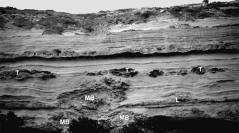

 Geodiversitas
24 (3) - Pages 611-623
Geodiversitas
24 (3) - Pages 611-623In the Messinian of western Sicily (Salemi basin) and Sardinia (Sinis peninsula) bryozoans are often associated with microbialite build-ups. Inside these constructions, three types of relationships between bryozoans (24 species) and microbialite are distinguished: 1) massive nodular colonies of cellepores within microbial patches; 2) more or less convoluted sheets belonging to an encrusting species, also within microbial patches; and 3) encrusting bryozoan colonies and serpulid worms covering the microbial crusts lining the cavities of the coral framework. The first two types of associations correspond to real bioherms tightly associating bryozoan colonies and microbial crusts. They constitute a compact and hardened structure, often several metres high, on which various communities of organisms will later settle: bivalves essentially on the top surfaces, encrusting bryozoans and serpulids in cryptic habitats. All these build-ups developed in a shallow-water, normal marine environment, associated with coral reefs in Sicily. The observed bryozoan-microbialite relationships correspond to the kind of interaction between microbial films and bryozoans that has also been identified in the Recent. This type of association represents a new modality among the already diversified biosedimentary events of the Messinian.
Microbialite, bryozoans, Messinian, Sicily, Sardinia